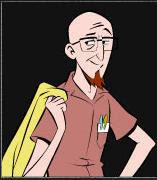In chemistry, we teach you that there are five simple reactions: synthesis, decomposition, single replacement, double replacement, and combustion. Synthesis is bringing two or more pieces together to form a new unit. Decomposition is shit falling apart. Single and double replacement reactions are pretty straight-forward: they're just switching things out for something new. Combustion reactions, however, are the stuff of dreams. Or the dreams of Tuesdays, at the very least.
 |
| I have a new lab assistant. |
Organic chemistry is the study of the element carbon and all of its myriad fascinating compounds...with the notable exceptions of carbon dioxide and calcium carbonate (and other metallic carbonate salts...mostly...sort of...um...let's move on). These compounds are usually considered to come from non-organic, or non-living, sources...even though animals exhale carbon dioxide and plants take carbon dioxide and form it into sugars. Oh, and sea creatures make a literal shit ton of calcium carbonate that we use to build things with and as decoration. Um...again, let's move along.
One thing about organic compounds is that they feature carbon and hydrogen. Usually, they feature a lot of carbon and hydrogen. We chemists, always a clever lot, refer to compounds that feature a lot of hydrogens and carbons as "hydrocarbons." Brilliant, eh? I thought so, too, as did many of my predecessors! Now, when you mix together hydrocarbons and oxygen and add in just a touch of flame, something wonderful and enchanting happens!
*inhales deeply* Magnificent!
What you are seeing here is the mixture of ethanol--yes, the same ethanol that causes you text some gorgeous red-headed girl in the middle of Pennsylvania at three in the morning--vapor, oxygen, and just enough of a heat source to get this thing going. Since the neck of the vessel is narrow, the fire cannot reach all of the vapor at the same time, so that's why you see that lovely cascade of fire sliding down the insides of the plastic bottle. The ethanol has pooled a little in the bottom, which is why the bright yellow flames dance in the middle of the bottle once the cascade has reached the bottom. Heat from the fire has caused the air to warm and rise toward the opening of the bottle, which is why the dancing flames are climbing toward freedom as the fire begins to extinguish itself.
Now, I know I just talked about hydrocarbons, and technically ethanol is not a hydrocarbon; it's an alcohol, which means it has an oxygen inserted between one carbon and one of its hydrogens. In theory, you could do this with any hydrocarbon with a low enough boiling point that it's a vapor at room temperature. Butane comes to mind. As does gasoline (octane)--both of which are hydrocarbons. Unfortunately, I personally would not try that; the combustion reactions of these gases are pretty spectacularly exothermic (they're hot), and that could cause some issues. What kind of issues? Let's find out.
Caveat time: the "whoosh bottle" is a pretty simple experiment, but you need to make sure you're safe doing this. After you swirl the ethanol around inside the bottle, dump out the excess liquid. Make sure the bottle is not cracked or structurally compromised. And, for the love of God and anything else you might find even the slightest bit holy, be fucking careful.
Why? What happens if you're not careful and don't follow the instructions? You'll end up like this dipshit here:
Fortunately, no one was hurt. I don't know if the bottle was cracked or if there were any other issues, but the excess ethanol was not dumped out. That left way too much fuel for the fire and the expansion of the gasses trapped inside the bottle was too rapid for the bottle to hold together. Thus, kaboom.
In the top experiment, the phenomenon witnessed is called "deflagration," where the fuel is ignited and burns away until no more fuel is left to consume. It's like a very fast, very hypnotic, very pretty log burning in the fireplace.
The second is a detonation, because the container couldn't hold it and everything went boom.
And notice, aside from some bad glasses on the teacher's face, no safety equipment was used (although flannel shirt girl did have the fire extinguisher ready and handy for the teacher to use). Safety first...or, somewhere in the top five.







0 comments:
Post a Comment